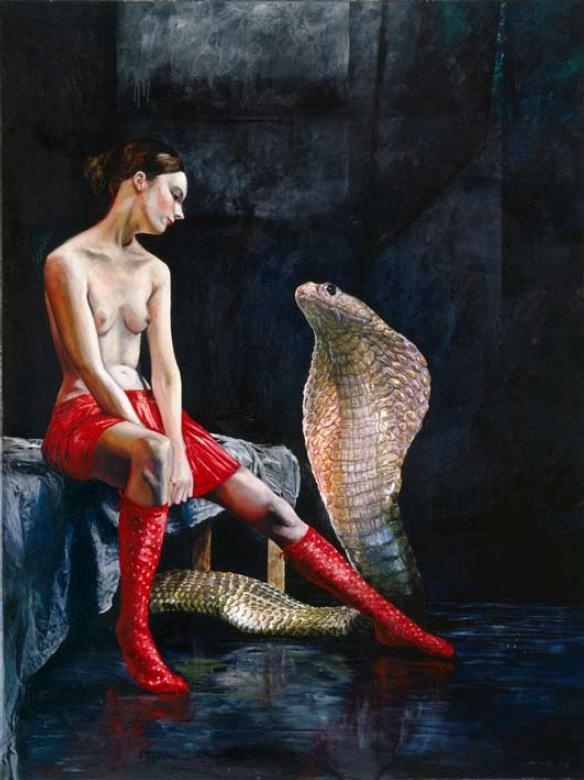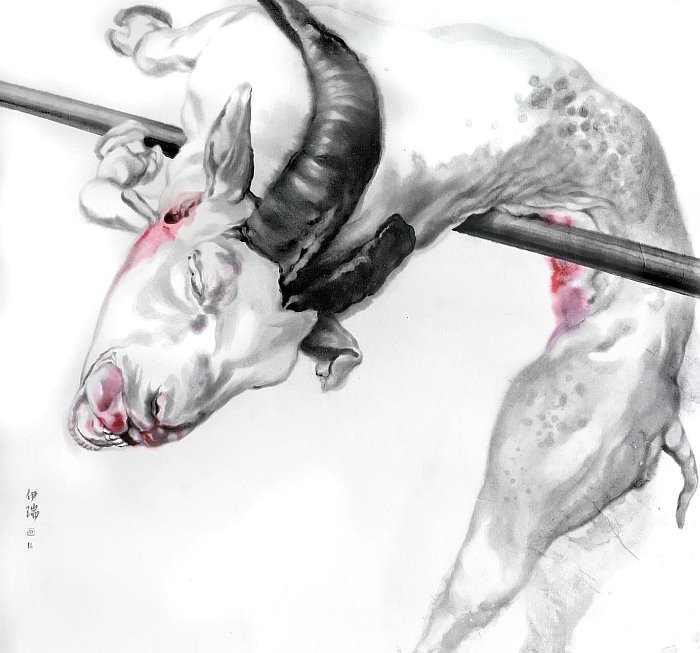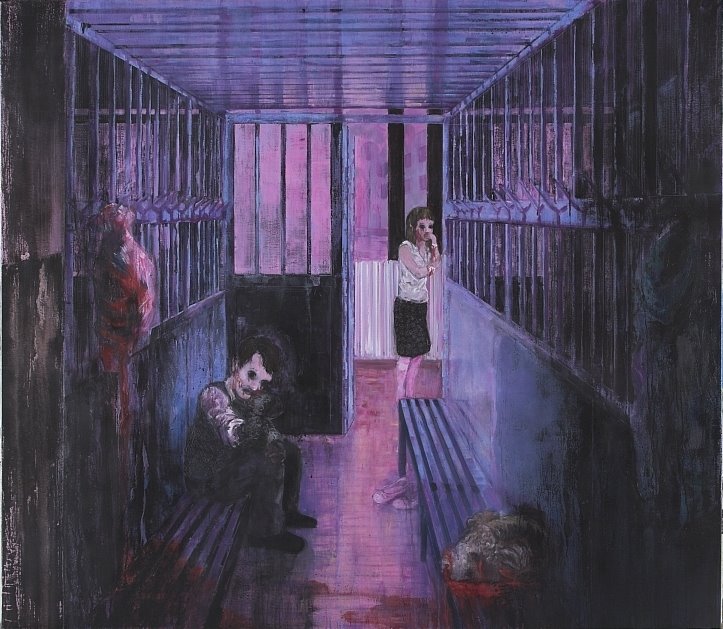Gallery Rudolfinum, Prague, May 7, 2009 – Aug 16, 2009
The show displays recent works of four middle-aged artists, three painters and one sculptor. “What all of the artists have in common is a firm basis of deeply understood and mainly experienced history of European culture and the artistic legacy with which they work.” – says the official PR text of the gallery. For me the keywords for this exhibition were classical (technique) and fantasy (subject matter). Each of these keywords can be elaborated further.
The classical techniques of representation used by the authors is what the above mentioned quote is referring to as the “European culture and artistic legacy”. Each of the authors aproaches the problem of technique from a different angle. Eder’s chiaroscuro oil painting refers to the classic realist tradition dating back all the way to renaissance. Straka utilizes the technique of chinese ink painting, creating a intercultural tension. Meese draws on the centuries long figurative tradition of European sculpture. Bolf is most ambiguous in his approach to technique and so can be percieved as the most innovative. His technique originates from painting, yet he adss color crayons or scratches the paint at some points.
In the depicted subject matter the fantastical, magical and dream-like seems to serve as the common ground. Surrealism and its main topics was definitely a source for all of the authors. Yet the approaches differ.
Meese’s sculptures keep the general volumes of known objects – animal and human bodies, busts, etc. Yet they are morphed in un-real ways. They are a cross-breed between aboriginal art – emphasising symbols of fertility and sex – and science fiction – depicting human-alien-machine mutations. The sculptures are pointing in both future and past direction. (Of course is is a question, whether it makes any sense to talk about directions in a postmodern, timeless, world.). One can hear the echo of H.R.Giger’s work, but there is a deeply organic and primitive feel on the other hand.
 Eder’s paintings come closest to the tradition of magical realism. Realistic yet not real. Like dreams. Some painting’s real feel is put into a new context by certain details: Two furry kitties, colourful butterflies – a typical cheap kitsch kitchen decoration – yet instead of a blue sky and green meadow, there are moon-lit clouds in the background. You have seen all this before. Yet the transpositions give rise to a new kind of reality. Eder seemed to represent the most ‘classical’ position of the 4 artists in the end. Both the form and subject matter could be clearly placed into the European tradition of painting. This took away some of the ‘surprise’ factor, but it did not diminish the facinating dream-like state emanating from the works.
Eder’s paintings come closest to the tradition of magical realism. Realistic yet not real. Like dreams. Some painting’s real feel is put into a new context by certain details: Two furry kitties, colourful butterflies – a typical cheap kitsch kitchen decoration – yet instead of a blue sky and green meadow, there are moon-lit clouds in the background. You have seen all this before. Yet the transpositions give rise to a new kind of reality. Eder seemed to represent the most ‘classical’ position of the 4 artists in the end. Both the form and subject matter could be clearly placed into the European tradition of painting. This took away some of the ‘surprise’ factor, but it did not diminish the facinating dream-like state emanating from the works.
 Straka’s use of Chinese ink painting makes him stand out. Even the “European culture and legacy” refered to above is used in a different way. The technique and subject are swapped with regard to the heritage they draw on. The European lineage is followed in the depicted subject matter. The expressivity and referrals to death / vanitas give the paintings a late baroque feel. Dead animals, insects and inner organs seem to be the antithesis to the chinese-buddhist tradition of harmony with oneself and nature, respect for all living beings. Yet even in the chinese context, they represent the tension between earthly reality and scholarly philosophy/religion. I am not aware whether there is any moment is Chinese art with a similar array of meaning as vanitas in the christian tradition – a reminder of the transience of life, the futility of pleasure, and the certainty of death. The formal aspect is connecting Staka’s works to the Chinese tradition. It makes it difficult to compare Straka with the other “European” artists. The inherent tension between the subject and form/technique, the east-west tension is at the core of Straka’s work.
Straka’s use of Chinese ink painting makes him stand out. Even the “European culture and legacy” refered to above is used in a different way. The technique and subject are swapped with regard to the heritage they draw on. The European lineage is followed in the depicted subject matter. The expressivity and referrals to death / vanitas give the paintings a late baroque feel. Dead animals, insects and inner organs seem to be the antithesis to the chinese-buddhist tradition of harmony with oneself and nature, respect for all living beings. Yet even in the chinese context, they represent the tension between earthly reality and scholarly philosophy/religion. I am not aware whether there is any moment is Chinese art with a similar array of meaning as vanitas in the christian tradition – a reminder of the transience of life, the futility of pleasure, and the certainty of death. The formal aspect is connecting Staka’s works to the Chinese tradition. It makes it difficult to compare Straka with the other “European” artists. The inherent tension between the subject and form/technique, the east-west tension is at the core of Straka’s work.
 Bolf surprised with a brand new series of paintings, all dated 2009. The paintings are all set in the architectural space of a primary/secondary school: A classroom with little chairs, a dressing room, a canteen… Yet in Bolf’s depiction, it is a memory-turned-nightmare. Among torn-apart human and animal body parts, a male and female survivor are reeling around, bleeding. Compared to Eder, the painting technique is less classical/realistic. It has a more rough feel, consistent with the rough subject matter of the imagery. The resulting impression is somewhere between surrealism, horror and hentai manga.
Bolf surprised with a brand new series of paintings, all dated 2009. The paintings are all set in the architectural space of a primary/secondary school: A classroom with little chairs, a dressing room, a canteen… Yet in Bolf’s depiction, it is a memory-turned-nightmare. Among torn-apart human and animal body parts, a male and female survivor are reeling around, bleeding. Compared to Eder, the painting technique is less classical/realistic. It has a more rough feel, consistent with the rough subject matter of the imagery. The resulting impression is somewhere between surrealism, horror and hentai manga.
 Bolf’s work had the strongest impact in terms of engagig the viewer. Maybe it was caused by the density – they covered most of the walls, you were surrounded by them. Maybe it was caused by relating to the viewer’s past memories – the school environment depicted is a part of our common memory. Maybe it was caused by the freshness and same subject matter of all the paintings. Bolf’s paintings came most close to a spacial installation.
Bolf’s work had the strongest impact in terms of engagig the viewer. Maybe it was caused by the density – they covered most of the walls, you were surrounded by them. Maybe it was caused by relating to the viewer’s past memories – the school environment depicted is a part of our common memory. Maybe it was caused by the freshness and same subject matter of all the paintings. Bolf’s paintings came most close to a spacial installation.
The gallery outline which placed each artist into a separate room created the impression of four loosely connected solo shows, which was quite suitable. I cannot imagine the paintings hanging next to each other, as each author wraps them in its own, quite unique aura. The exhibition showed clearly the positions of each of the painters. Bolf was impressive, yet in the context of his other work not so surprising. Eder showed a mixture of paintings, representing the last cca 4 years of his work, which mainly served to remind us of his known qualities. Meese’s sculptures fit in in the exhibition context, yet they were most remote from my personal taste. Straka’s painting’s created a very refreshing feel though the tension between form and subject matter. He is probably the biggest surprise of this show.